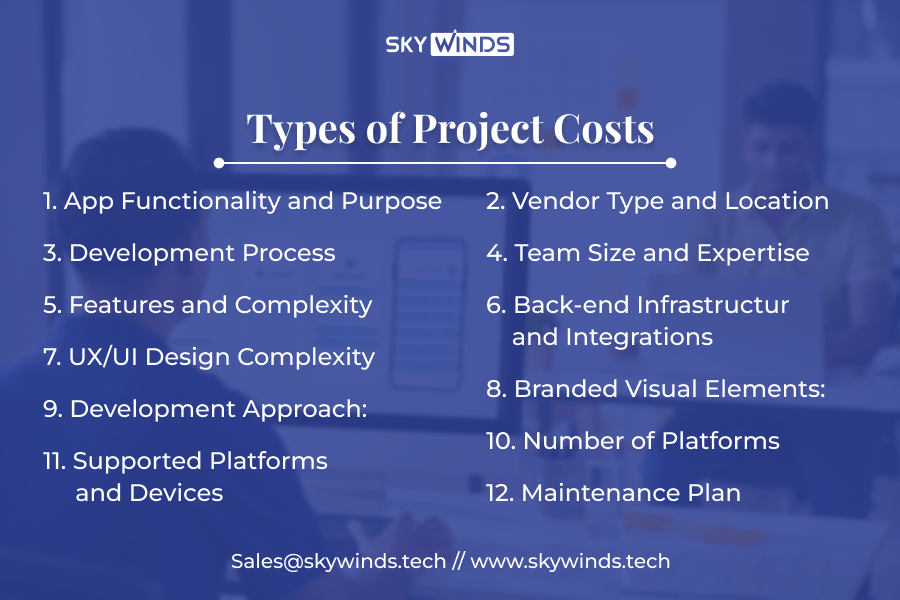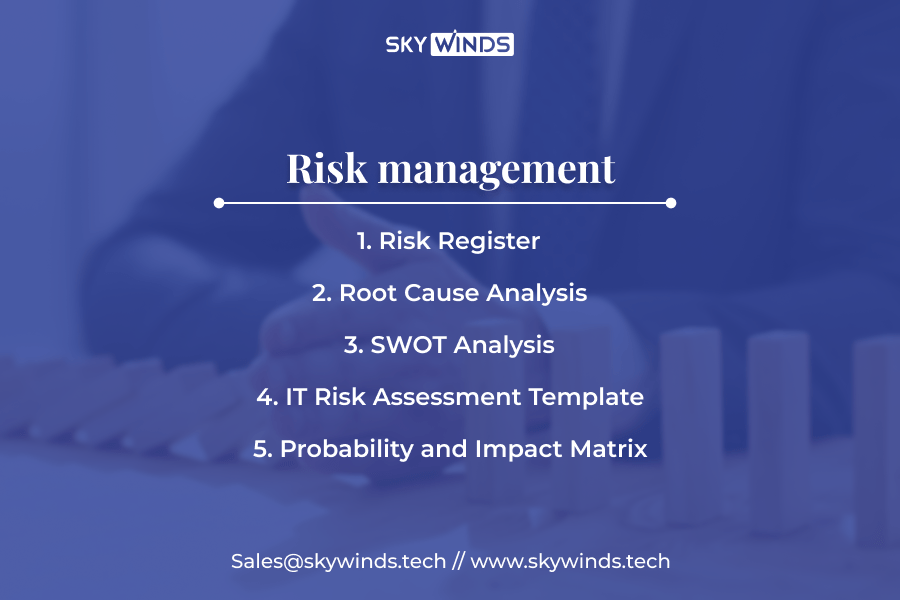
Developing an app can expand your business reach, but the process can be intimidating, especially with uncertain costs.
The cost varies based on factors like your business goals, desired app features, user flows, and budget. Success in app development requires a clear plan outlining the app’s purpose, necessary features, and budget allocation.
This article will delve into the factors influencing app development costs and offer tips to minimize them. By comprehending the app development process and adopting a strategic approach, you can craft an app aligning with your business objectives without overspending.
Definition of project cost management
Project cost management is the process of planning, estimating, budgeting, financing, funding, managing, and controlling the costs of a project from start to finish. It involves identifying all the costs associated with a project, including direct and indirect costs, and creating a budget that can be tracked throughout the project lifecycle.
Importance of effective cost management in app development projects
Effective cost management is vital in app development projects for overall success and sustainability. It helps keep the project within budget, achieve set goals, and deliver quality outcomes.
Optimized cost management allows for resource maximization and informed decision-making based on accurate financial data. It also mitigates risks associated with app development.
Ultimately, proper cost management enhances the project’s profitability and success. By closely monitoring costs, developers can increase project value and ensure positive outcomes for all stakeholders.
Understanding Project Costs
With over 7 billion smartphone users worldwide and increasing, developing a mobile app can be a smart strategy. App development costs and timelines vary depending on complexity and features:
1. Average minimum cost: $5,000 to $10,000.
2. Median cost for iOS app development: $25,275 to $114,300, assuming 1,143 development hours at $100/hour.
3. Complex apps could cost up to $500,000.
4. Average enterprise app cost: $140,000.
5. Over 80% of mobile apps take 3+ months to develop; 40% take 6+ months.
App cost calculators suggest a price range of $10,000 to $50,000 for basic apps and $200,000 to $350,000 for complex, multi-feature apps.
Types of project costs

1. App Functionality and Purpose: The more complex the functionality, the higher the cost.
2. Vendor Type and Location: Costs can vary based on the region and the expertise of the vendor.
3. Development Process: The methodology and tools used can affect the overall costs.
4. Team Size and Expertise: Larger teams with higher expertise may charge more.
5. Features and Complexity: More features and higher complexity increase costs.
6. Back-end Infrastructure and Integrations: The need for a robust back-end and various integrations can add to the costs.
7. UX/UI Design Complexity: Intricate designs require more work and hence increase costs.
8. Branded Visual Elements: Additional branding elements can increase development costs.
9. Development Approach: Whether the app is native, mobile web, hybrid etc., affects costs.
10. Number of Platforms: Developing for multiple platforms (iOS, Android, web, etc.) increases costs.
11. Supported Platforms and Devices: The more platforms and devices supported, the higher the cost.
12. Maintenance Plan: Ongoing updates and maintenance can add to the total cost of the project.
Cost estimation techniques
Essentially, three prevalent techniques exist for determining the cost of your app development project.
1. Ballpark Estimation: This method gives a rough average cost based on past experiences and speculations. It’s not very precise but gives a general idea of the potential cost. Typically, an experienced software development firm can provide a ballpark estimate.
2. Parameter-based Estimation: This involves using historical data and actual calculations, making it more accurate than the ballpark method. It involves calculating the duration of each task and multiplying it by the team member’s hourly rate, resulting in a more precise estimation but requiring more time management.
3. Three-point Estimation: This method incorporates risk analysis, providing three potential cost outcomes: optimistic, pessimistic, and realistic. The pessimistic value factors in potential risks, offering a worst-case scenario cost. The optimistic cost reflects the best-case scenario where everything proceeds perfectly, while the realistic scenario lies somewhere in between.
Cost budgeting and control
Curious about how to ensure your app development project stays within budget? Here’s how to manage and control costs without compromising quality:
1. Discovery Phase: Don’t skip the initial research phase. Understanding technologies, platforms, competitors, and your target audience can help prevent costly errors.
2. Choose the Right Vendor: Research potential vendors thoroughly. Look at their past projects and reviews. Reputable software development companies can help you establish and stick to a realistic budget.
3. Consider Outsourcing: Outsourcing to regions with lower rates, like app development companies in India, can help keep costs down.
4. Start with an MVP: Begin by developing a Minimum Viable Product (MVP) with only the essential features. This approach keeps initial costs down and allows you to test the market response before investing more.
5. Keep Design Simple: Start with a straightforward, clean design. You can always introduce more complex elements after the initial launch is successful.
6. Accurate Cost Evaluation: Start with a rough estimate, but refine this with a more detailed cost analysis after the discovery phase.
7. Scope Management: Stick to your initial project scope. While it can be tempting to add more features, keeping the initial version of the app focused can help manage costs. You can always expand in later versions.
The Project Cost Management Process
Managing costs in project management involves strategizing, evaluating, and controlling budgets throughout the project life cycle. While cost management can be complex, it’s essential to project success and can be divided into four key processes:
Steps involved in project cost management
Step #1: Plan the resources
The first step in cost management is planning resources, which includes examining the project scope and forecasting necessary resources. The project scope outlines all tasks to be accomplished to complete the project.
Project resources may include:
- The number of people required,
- The level of experience needed,
- The equipment required, and
- Specific timelines for each activity.
Essentially, resources are anything that contributes to successful project completion. Despite careful planning, unforeseen challenges may arise, potentially making certain resources unavailable. Therefore, it’s important to monitor resource allocation closely. This helps project managers understand what’s required and assists in task delegation.
Step #2: Estimate the cost of resources
Once the resource planning part is complete, it’s crucial to estimate the costs of the allocated resources. Accurately calculating the cost of each resource and accounting for variables is essential for making informed decisions about supplies, tools, and the overall project budget. After gathering the necessary pricing information, you can determine an estimated expense calculation.
To ensure the most accurate numbers, consider the following:
- Tracking project time and expenses,
- Monitoring the activities of all project participants, and
- Observing real-time expenditure patterns.
Now that we’ve covered resource cost estimation let’s move on to the third step: cost budgeting.
Step #3: Determine the cost budget
Establishing the cost budget is at the heart of project cost management. In essence, a cost budget is the aggregate of all costs associated with tasks and milestones that the project is designed to achieve. Understanding your cost budget enables you to manage actual costs in relation to estimated ones.
The cost budget heavily relies on the project schedule. Being mindful of task durations and milestones aids in tracking project deadlines. A well-defined cost budgeting strategy empowers project managers to make more precise budget estimates for future phases and potentially avoid cost overruns.
Step #4: Control the costs
Cost control involves closely monitoring and recording all costs throughout the project’s progression. This allows for timely adjustments in response to changes such as material or service price fluctuations. Cost control is crucial in minimizing expenses and maintaining project profitability.
Here are some strategies for effective cost control:
- Ensure the project stays within its defined scope,
- Collaborate with stakeholders,
- Adhere to the schedule and manage time effectively, and
- Utilize project management software for better oversight.
Benefits of following a structured cost management process
Implementing a structured cost management plan for app development companies comes with several advantages:
1. Budget Control: This process helps control the budget and ensure that resources are used effectively. It allows you to identify cost overruns early on, enabling you to take timely corrective actions.
2. Reduced Risks: By having a clear understanding of costs and budget, companies can significantly reduce financial risks. Predictable costs also make it easier to forecast future expenses, aiding in overall financial planning.
3. Improved Decision Making: With a structured cost management process, companies can make more informed decisions. They can allocate resources better, prioritize projects, and make strategic changes based on cost considerations.
4. Enhanced Profitability: Effective cost management can help increase profitability. By understanding where and how money is being spent, you can identify areas of inefficiency and work to reduce unnecessary expenses, thus increasing the bottom line.
5. Better Pricing Strategy: Understanding the cost structure of developing an app can help in creating a more accurate pricing strategy. This way, you can ensure a healthy margin while staying competitive in the market.
6. Stakeholder Confidence: Transparency in cost management can build trust among stakeholders, including investors, employees, and customers. It demonstrates that the company is financially responsible and well-managed.
7. Scalability: A well-defined cost management process is scalable. As the company grows and undertakes more complex projects, the process can be adjusted accordingly to manage costs effectively.
8. Resource Optimization: By tracking and analyzing costs, companies can identify areas where resources (both human and material) may be under or over-utilized and can then take steps to optimize their use.
9. Project Success: Many projects fail due to poor cost management. A structured process for managing costs can greatly increase the chances of a project’s success, as it ensures that the project is completed within budget.
10. Investor Attractiveness: For companies seeking investment, demonstrating a solid approach to cost management can make them more appealing to investors. It shows that the company is capable of managing its financial resources effectively, reducing the risk associated with the investment.
Remember, while the cost management process is crucial, it’s equally important to balance cost efficiency with quality to ensure the app’s success in the competitive market.
Project Cost Management Tools and Techniques
Project management software
There are a plethora of project management software tools that can be beneficial for managing project costs in app development companies. Here are a few notable ones:
1. Jira: Known for its versatility, Jira is a project management platform that provides features for cost tracking and budget supervision. Its custom reporting, time tracking, expense management, and workflow control features make it a robust tool for project cost management.
2. Trello: Trello’s project management platform provides a visually appealing way to manage projects. Teams can set up boards, lists, and cards to keep track of project progression and budget control. Its reporting abilities can further assist teams in cost tracking and identifying potential areas for improvement.
3. Smartsheet: This project management platform provides an array of functionalities for budget and cost control. Users can develop custom reports, track time, manage expenses, and handle project workflows. Its collaboration tools enhance team efficiency and streamline the project management process.
Earned value management
EVM is a project management technique that ties together schedule, costs, and scope to gauge project performance. By comparing planned and actual values, it forecasts future performance and allows for necessary adjustments.
Research by Fleming and Koppelman suggests that when 20% into a project, its current progress can predict the outcome within a 10% variance, thanks to EVM.
EVM offers numerous benefits, including:
- Translating work into quantifiable costs.
- Comparing the current status with the project baseline to identify crucial paths.
- Enabling data-driven decision-making.
- Allowing timely interventions, like adjusting scope and budgets or shifting resources.
- Increasing visibility and accountability through clear metrics.
- Offering a comprehensive overview at both project and portfolio levels.
Value engineering
Value engineering is a structured approach used to optimize the cost and function of a product or service. The primary goal is to provide the required function at the lowest possible cost without compromising on quality, performance, safety, and aesthetics. The principle equation to denote value is maximum performance divided by minimum cost.
A value engineering study can potentially reduce the total product cost by 5% to 40%. The study is generally divided into three stages: preparation, multi-phase job plan execution, and documentation with audits.
The multi-stage job plan, or ‘value analysis job plan’, is executed by a multidisciplinary team in six phases, though some teams might modify this to four or eight phases.
1. Information phase: The team reviews the project status and identifies areas of high cost and low worth.
2. Function analysis phase: The team understands the functional perspective of the project and identifies areas for improvement.
3. Creative phase: The team generates a multitude of ideas for alternative ways to perform the functions.
4. Evaluation phase: The team shortlists the ideas with the greatest potential to improve the project.
5. Development phase: The shortlisted ideas are developed into value alternatives with cost comparisons.
6. Presentation phase: The alternatives are presented to the decision-makers in a detailed report.
Risk management
Risk is an integral part of project management, and having a risk management plan is crucial. Good risk management ensures that projects are delivered on time, within budget, and of high quality. Here are some tools and techniques commonly used for risk management:

1. Risk Register: This essential tool helps identify, describe, and prioritize risks. It also outlines potential impacts and responses to risks, assigns responsibility, and provides space for notes. It’s a proactive tool to prevent projects from falling behind or exceeding budget.
2. Root Cause Analysis: This systematic process identifies fundamental risks within a project. Typically used after a problem arises, it focuses on causes rather than symptoms. By answering what, how, and why something happened, it aids in preventing recurrence.
3. SWOT Analysis: SWOT (Strengths, Weaknesses, Opportunities, Threats) is useful for identifying risks. Strengths and opportunities often indicate positive risks, while weaknesses and threats signify negative risks. It helps in visualizing and analyzing project objectives.
4. IT Risk Assessment Template: Although designed for IT projects, this tool can be adapted for any project. It provides a detailed list of risks, control activities, and other relevant information. It also includes a built-in calculator to estimate the likelihood and impact of risks.
5. Probability and Impact Matrix: This tool prioritizes risk by combining individual risk probability and impact scores, ranking them based on severity. It helps in understanding each risk in the context of the larger project and preparing a suitable response plan.
Resource optimization
Project Management employs resource optimization techniques to adjust project implementation and completion timelines, modify resource allocation, and manage resource availability. These techniques are part of Schedule Network Analysis, aiding in project schedule compression.
Two primary tools used in Resource Optimization Techniques are:
1. Resource Leveling: This method adjusts project start and end dates based on resource constraints. It balances resource demand by utilizing available resources at certain times and in specific quantities. Often, it changes the critical path of the project.
2. Resource Smoothing: This technique adjusts the schedule model activities to ensure the project doesn’t exceed pre-set resource limits. It maintains the project’s critical path, preventing a delay in the finish date.
Key Performance Indicators (KPIs) for Cost Management
KPIs are essential for app development companies to manage costs, improve profitability, optimize resource allocation, and make data-driven decisions about marketing and customer acquisition. By tracking KPIs related to cost management, app development companies can achieve long-term success and sustainable growth.
Examples of cost-related KPIs
Here are some Key Performance Indicators (KPIs) for Cost Management that an app development company can use:
1. Cost of Goods Sold (COGS): Tracks the direct costs tied to app production and delivery, like development and server costs.
2. Gross Margin: This shows the difference between revenue and COGS, indicating app profitability.
3. Burn Rate: Monitors the rate of cash expenditure, ensuring the company doesn’t overspend.
4. Return on Investment (ROI): Measures the financial returns from the app relative to its development and marketing costs, indicating its profitability and marketing effectiveness.
5. Customer Acquisition Cost (CAC): Tracks the cost per new customer, ensuring customer acquisition isn’t costlier than the revenue they generate.
6. Lifetime Value (LTV): Estimates the total revenue a customer will generate over their lifetime, helping allocate resources.
7. Cost Variance (CV): Shows the difference between actual and planned costs, aiding budget adherence and identifying cost-saving opportunities.
How to use KPIs to measure project performance
Using Key Performance Indicators (KPIs) to measure project performance is an essential aspect of project management. To use KPIs effectively, project managers need to follow a series of steps.
1. Define Objectives: Identify the project goals, including scope, timeline, budget, and quality standards.
2. Select KPIs: Choose measurable KPIs relevant to the project. These could be quantitative or qualitative, like budget variance or customer satisfaction. KPIs should be SMART (Specific, Measurable, Achievable, Relevant, and Time-bound).
3. Establish Targets: Define performance targets for each KPI based on project objectives, historical data, or industry standards. Ensure these targets are realistic yet challenging.
4. Track Progress: Regularly collect KPI data and monitor progress against targets. Use this data to spot performance gaps and make necessary corrections.
5. Analyze & Communicate: Analyze KPI data to identify trends, issues, and successes. Use this analysis to report project status to stakeholders.
6. Improve Continuously: Utilize KPI data to spot improvement opportunities and adjust the project plan as needed, including implementing best practices or corrective actions.
Challenges in Project Cost Management
Common challenges in cost management for app development projects include:
1. Scope Creep: Expansion beyond the initial project scope, leading to increased costs due to changing client needs or team decisions.
2. Resource Allocation: High demand for specialized skills or resources can cause cost overruns or delivery delays.
3. Unforeseen Costs: Unexpected costs, such as regulatory changes or technical issues, can disrupt the budget.
4. Inaccurate Budgeting: Misjudging project costs can result in budget deficits or unutilized surplus funds.
Strategies for overcoming cost management challenges
1. Clear Scope Definition: Prevent scope creep by defining project scope clearly and gaining stakeholder agreement.
2. Project Management Software: Use software to manage resources, track costs, and prevent unexpected expenses.
3. Risk Management: Identify potential risks and establish contingency plans to handle unforeseen costs.
4. Accurate Budgeting: Understand all project costs, review historical data, and use industry benchmarks for accurate budgeting.
5. Continuous Monitoring: Regularly monitor project costs and KPIs to detect early issues and communicate the project status to stakeholders.
Cost Management Best Practices
Keeping track of everything might seem a bit overwhelming. However, there are some key tips that will help you keep your mobile app development pricing under budget.
Examples of successful cost management practices
1. Communication: Ensure consistent team communication facilitated by methodologies like Agile.
2. Testing: Engage a dedicated QA team for testing, a complex but crucial process, and involve them in regular team meetings.
3. Feedback: Start gathering customer feedback early to understand user preferences, product value, and areas of improvement.
4. Flexibility: While sticking to the budget is key, some flexibility is essential in the evolving IT market. Be open to modifying plans based on customer feedback.
Importance of continuous improvement in cost management
Continuous improvement is crucial in cost management for app development companies in USA because it allows them to identify areas for improvement and make necessary changes.
Here are some reasons why continuous improvement is important in cost management:
1. Uncovers Cost-Saving Opportunities: Through continuous evaluation of cost data and performance metrics, companies can spot and action cost-saving measures.
2. Streamlines Processes: Identifying bottlenecks and areas for process optimization can reduce waste and enhance resource utilization, leading to cost reduction.
3. Adapts to Change: Continuous improvement allows companies to adjust to shifting market demands and technological advances, maintaining competitiveness and innovating to reduce costs over time.
4. Boosts Customer Satisfaction: Companies can enhance their products and services, meet customer expectations, and increase loyalty by consistently seeking and implementing improvements.
5. Secures Long-Term Success: Regular performance and cost data review, coupled with implementing cost-saving measures, ensures the company’s profitability and sustainability in the long run.
Conclusion
Effective cost management is crucial for app development companies to stay competitive, deliver quality products, and maintain financial health. It involves accurate cost estimation, realistic budgeting, expense monitoring, and regular financial reviews.
Adopting agile methodology, using cost management tools, and promoting transparency and collaboration can enhance cost management. Successful cost management keeps projects within budget, aids in informed decision-making, improves stakeholder management, and fosters long-term growth.
By continually refining their cost management, app development companies can gain an advantage in the fast-paced digital world.
FAQs
1. What are the main benefits of effective project cost management?
Effective project cost management provides app development companies with several benefits, including the ability to accurately forecast costs, identify cost-saving opportunities, and allocate resources effectively. It also helps to ensure that projects are completed within budget, improves stakeholder satisfaction, and increases the overall profitability of the company.
2. How do you estimate costs for app development projects?
Estimating costs for app development projects can be a challenging task, but it is essential for effective project cost management. Here are some of the key steps in estimating costs for app development projects:
- Define project requirements
- Identify project resources
- Estimate time required
- Calculate costs
- Account for contingencies
- Review and refine estimates
3. What are some of the most common challenges in project cost management?
Project cost management is a complex process that involves many different factors, and there are several common challenges that can arise during the course of a project. Here are some of the most common challenges in project cost management:
- Poor cost estimating
- Scope creep
- Inaccurate tracking of costs
- Lack of communication
- Poor risk management
4. What are some best practices for effective project cost management?
Effective project cost management is essential for the success of any project, including app development projects. Here are some best practices for effective project cost management:
- Develop a detailed project plan
- Conduct accurate cost estimates
- Cost monitoring projects
- Implement change control
- Manage project risks
- Use project management software
- Regularly review and adjust the project plan
5. How do you measure the success of project cost management efforts?
Measuring the success of project cost management efforts is essential for evaluating the effectiveness of cost management strategies and identifying areas for improvement. Here are some ways to measure the success of project cost management efforts:
1. Actual vs Planned Cost: Compare the actual project expenses with the planned budget to assess how well costs were controlled.
2. Cost Variance Analysis: Analyze the differences between planned and actual costs to pinpoint where expenses were above or below expectations, helping identify cost-saving opportunities.
3. Return on Investment (ROI): Calculate ROI by comparing project cost with the benefits or revenue it generated.
4. Earned Value Analysis (EVA): EVA measures the value of completed work against its cost, helping track project progress and spot potential savings.
5. Stakeholder Satisfaction: Gather feedback from stakeholders on their satisfaction with the project budget and cost management efforts.

